Thurston Pond Gets Its Thirst On
Heading east out of downtown Ann Arbor, by the time Plymouth Road nears the 200-foot-high, 500,000-gallon water tower – painted with blue sky and clouds – west side Ann Arbor residents who stick mostly close to their own neighborhoods could easily forget this is still Ann Arbor. A couple of weeks ago The Chronicle headed up that direction, turning left just before the water tower onto Georgetown Boulevard. We were meeting Neal Foster, a neighbor of Thurston Pond and retired scientist, who had agreed to give us a tour of this 8.5 acre pond, which is a major feature of the Thurston Nature Center.
In his early academic career – inspired in part by his father’s guppy tank – Foster’s research specialty was killifishes, but what he says he’s best at and enjoys most is “explaining things to people.” And The Chronicle took full advantage of that talent. After gathering up some buckets, nets and waders at Neal’s house, we headed up to the southern edge of the pond where Yorktown Drive provides easy access. Before donning the waders and Wellingtons in an attempt to gather some aquatic creatures, we took a clockwise tour of the pond.
As we began working our way around the pond, Thurston Elementary’s playground was on our left. The Thurston Nature Center is intimately connected to the school – The TNC Committee is a sub-committee of the Parent Teacher Organization at Thurston Elementary. Piled next to the first section of trail was a heap of wood chips, which Foster explained would be spread by volunteers onto the trail as a part of a work detail scheduled for an upcoming weekend. Walking the trail, we encountered benches oriented towards the pond, which presumably at one time had a sight-line to the water, but any glimpses of the pond today from those benches are obscured by phragmites (an invasive reed) or else by the towering willow trees.
Clear sight lines to the water probably existed back in the late ’60s when the pond took its current shape. The existing wetland had been dug out as the area was developed residentially, and some of the construction debris was tossed into the 2- to 6-foot deep pond.
As we neared the western side of the pond, Foster pointed out a grate amongst the vegetation: an overflow storm drain leading to Miller’s Creek. It rarely comes into play, said Foster. The settling over time of the berm on the western side of the pond, which is designed to keep the water levels higher, means that when the pond does overflow, it tends to do so at locations other than the designed drains, and winds up soaking into the ground, instead of being led to Miller’s Creek via the drains.
Overflow per se is not something to be prevented. On the contrary, what Thurston Pond needs, says Foster, is more flow in and more flow out, to help correct what has become an over-rich nutrient mix in the water. Where does the flow-in come from? It currently comes from natural pooling of water when it rains. In that regard, Thurston Pond is akin to a giant rain puddle. But in addition to the natural pooling, there is engineered flow as well. Just past a wooden walking bridge on the western edge of the pond we found the opening of the storm drain from the Clague Middle School parking lot into the pond.
A little further along the path, Foster pointed out a concrete stairway leading down from the Bluett Road and Antietam Drive area, which he said could be the location of an additional storm drain inlet into the pond. The 30-inch pipe would be installed by tunneling under the stairway instead of trenching and replacing the stairway – a newly re-constructed stairway would incur the additional expenses associated with being ADA compliant.
The wooden walking bridge we had crossed earlier had a newly replaced board on it. Asked who would have undertaken the repair, Foster figured it could have been Mike Conboy, the same name he cited as a real resource for information on the old growth trees we had been walking past.
As we made the turn eastward and rounded the deepest section of the pond, it became increasingly easier to get a view of the water. This is in part due to the practice of clearing brush all the way to the water’s edge by homeowners whose property abuts the pond. Foster said he wished they would let the natural flora have its way. Arriving back at the Yorktown Drive access, he said that the implementation of a no-mowing strategy at that location by the Orchard Hills Athletic Club had successfully discouraged the flocking of Canadian geese on the banks – which, unchecked, will make a prodigious contribution of manure to the lawn.
It was time for Foster to pull on his waders. The Chronicle pulled on some size-13 Wellingtons that he lent us, which were more than adequate to keep our feet dry. Foster first deployed a fine mesh suitable for snagging plankton-size aquatic life, taking care to swish his figure-eights through the water near the surface to protect the delicate weave of the net. Depositing the contents from the net into a plastic jar, he would later speculate that it was only detritus that had been captured.
But when Foster broke out the coarser net, he met with more visible success: fathead minnows. And that success was witnessed by Laura MacGregor, who was walking home with her daughter, Sophie Stillwagon, who she’d picked up from kindergarten at Thurston Elementary. MacGregor said they walked home past the pond nearly every day. Foster encouraged the pair to come to the upcoming Orchard Hills-Maplewood Homeowners Association fall festival – having some aquatic critters on hand for display at the festival was the motivation for the morning’s collection activities.
Fathead minnows aren’t the only aquatic life supported by Thurston Pond. Painted turtles and snapping turtles are definitely on the list as well. Foster said that the snapping turtles had a fairly easy time preying on ducklings and goslings, because the cloudy water allowed them to approach undetected. Not that the snapping turtles of Thurston Pond pose a real danger to humans – The Chronicle emerged from the shallow water unscathed, but with a deeper understanding of the range of neighborhoods in the city.




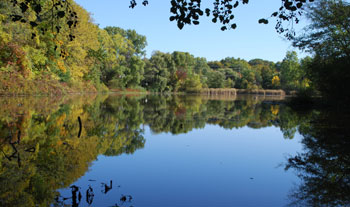
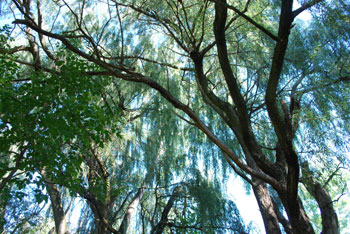
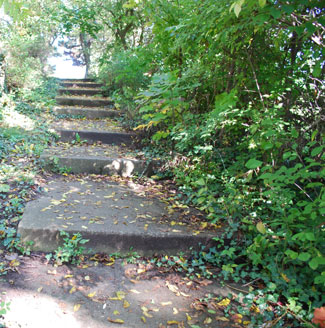
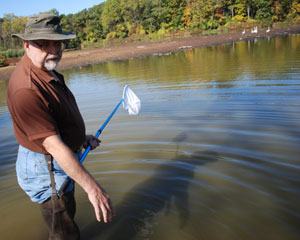
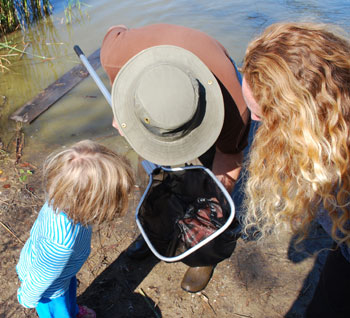
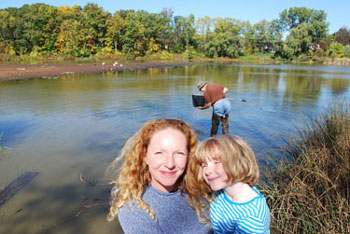
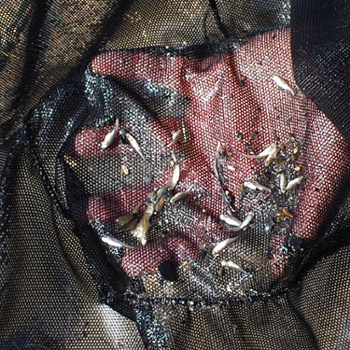
Dave – this is just great, lucidly and delightfully written. It demonstrates that you are a careful listener and notetaker. Thank you!
Two comments – within a few hours, after the detritus in the “plankton jar” settled out, the water turned out to be full of copepods, tiny tadpole-shaped crustaceans that would serve as the principal food of the fathead minnows.
The “waders” are more properly referred to as hip boots.
Great article. I grew up in a house that backed up to Thurston pond and I have many fond memories. I used to fish for bullheads with my dad, feed bread to the ducks, venture onto the ice in the winter, and walk or run through the border trail. The snapping turtles used to come out of the pond to lay eggs in our backyard, and one day we found one scratching at our garage door trying to get in the house. I also proposed to my wife on the bridge you mentioned…
I also enjoyed the article and grew up three houses from Thurston Pond. It was a magical place to grow up and at that time a small creek flowed behind my house which added to the richness of built-in play areas, frogs, snakes, and all kinds of creatures to find! Add to that skating on Thurston Pond was a winter ritual which included looking across the pond every winter day to see if the flag raised by an unknown person was red or green – giving us the okay to skate! Fishing was a huge summer event where you learned how to first hook the worm, unhook the fish and take the wayward hook out of friends heads every once in a while! I am so glad there are still caretakers of this urban pond! It is truly a fond part of my childhood!
Having grown up in this neighborhood and attending Thurston Elementary, I consistently helped out with spreading the woodchips. Mostly what I remember on those days is the vast array of adventures to be had exploring in the cat tails or on the “island”.
Also, some of my favorite photos I took during a photography class in high school were snapped with my dad’s old SLR around the pond.
Thanks for the article — it’s great to hear about the continuing interest in our ever-important natural spaces!
Superb article Dave. Hopefully, this draws Neal and Thurston Pond some of the attention they deserve.
For part of my childhood, I lived close to the pond on Scio Church Rd. It was a magical place that brought out the Tom Sawyer adventurer in us in the summer and dreams of becoming the next Gordy Howe in the winter.
The Orchard Hills Maplewood Association is the perfect archetype of a homeowners association taking charge of their own destiny and improving their neighborhood.
Dave
Thurston pond is part of the headwaters of Miller Creek, which I was involved in studying with other volunteers from the Huron River Watershed Council. Ponds like this one are an important connection to our understanding of our environment, the river, and education for all. Thanks for the article.
Thanks to Neal and Dave for this great article. I encourage everyone to check out the Thurston Nature Center web page at http://www.thurstonnaturecenter.org
We have lived on Prairie St. across from Thurston for 45 yrs. now. As the first Girl Scout leader, my troop planted sprigs of weeping willow trees recommended by Bill Stapp to encourage birds to come to the pond. What a delight this pond has been -used as an ice rink for skating and hockey in winter and fishing, feeding geese, etc. in summer months. Like all things it is now overgrown and stagnant. Any plans to revitalize the pond would be welcome.